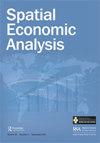空间溢出效应和财政刺激的影响:来自大流行时期联邦政府对州和地方政府援助的证据
IF 2.2
3区 经济学
Q2 ECONOMICS
引用次数: 1
摘要
摘要我们分析了在COVID-19大流行期间,美国联邦政府对州和地方政府的援助是否通过直接或跨州溢出效应影响了经济活动。采用工具变量框架,基于国会中席位过多的州的资金优势,我们发现,联邦援助对州和地方政府就业以及更广泛的经济活动指标的影响,明显小于先前危机应对所暗示的估计。我们发现,适度的就业影响主要来自各州自己的援助分配的直接影响,而不是跨州的溢出效应。这些研究结果表明,财政政策传导机制的差异发挥了重要作用,即当一些关键的溢出效应机制(如健全的跨司法管辖区供应链和消费模式)减弱或关闭时,跨州溢出效应就不太可能发挥重要作用。关键词:新冠肺炎就业;财政联邦制;财政政策;空间宏观经济;溢出效应[j]: E6H5H7空间溢出效应和财政刺激的影响:来自大流行时期联邦政府对州和地方政府援助的证据。AEI经济学工作论文2022-14。披露声明作者未报告潜在的利益冲突。注1这四项立法分别是2020年3月的《家庭第一冠状病毒应对法案》(FFCRA)和《冠状病毒援助、救济和经济安全法案》(CARES)、2021年12月的《应对和救济法案》(RRA)和2021年3月的《美国救援计划法案》(ARPA)。Nakamura和Steinsson (Citation2014)、Ramey (Citation2016、Citation2019)和Chodorow-Reich (Citation2020)为解释这些文献中的不同估计提供了框架我们使用了CRFB截至2019年8月19日的COVID-19资金追踪数据。正如Clemens和Veuger (Citation2021)所述,我们从美国联邦运输管理局(Citation2021a, Citation2021b)获得了RRA和ARPA过境资金分配的信息。ARPA对非公立学校的援助分配数据来自美国中小学教育办公室(Citation2021)。我们从Chidambaram和Musumeci (Citation2021)获得了ARPA section 9817匹配增长的估计。我们使用来自医疗补助和芯片支付准入委员会(Citation2021)的2021财年联邦不成比例份额医院分配估计数,来近似ARPA第9819条联邦匹配基金对无偿护理的分配。ARPA概述的冠状病毒资本项目基金是根据美国财政部的指导(Citation2021a)进行分配的每百万居民的国会代表人数计算为众议员人数+参议员人数/1,000,000。Clemens和Veuger (Citation2021)表明,赋予参议员人数更大的权重并不会从质量上影响国会代表过多和代表性不足的估计重要性为了完整性起见,在线补充数据的附录表A3中显示了各州在最接近区域法下配对的补充估计。同样,使用经济区域方法对各州进行配对的未加权估计可以在附录表A4.7中找到。值得注意的是,虽然保留工作是购买力平价和联邦对州和地方政府援助的主要目标,但这两个项目也都针对额外的结果。需要对所有目标结果进行更广泛的分析(这超出了本文的范围),才能对每个项目的成本效益进行全面比较。本文章由计算机程序翻译,如有差异,请以英文原文为准。
Spatial spillovers and the effects of fiscal stimulus: evidence from pandemic-era federal aid for state and local governments
ABSTRACTWe analyse whether US federal aid to state and local governments impacted economic activity through either direct or cross-state spillover effects during the COVID-19 pandemic. Deploying an instrumental-variables framework rooted in the funding advantage of states that are over-represented in Congress, we find that federal assistance had significantly less impact on state and local government employment, as well as broader measures of economic activity, than estimates from prior crisis responses would imply. The modest employment impacts we find stem largely from the direct effect of states’ own aid allocation, as opposed to spillovers across state lines. These findings point to an important role for variations in fiscal policy transmission mechanisms, namely that cross-state spillovers are less likely to be important when some of the key mechanisms for such spillovers, like robust interjurisdictional supply chains and patterns of consumption, are muted or shut down.KEYWORDS: COVID-19employmentfiscal federalismfiscal policyspatial macroeconomicsspilloversJEL: E6H5H7 ACKNOWLEDGEMENTThis article is based on the following working paper:Clemens, Jeffrey, John Kearns, Beatrice Lee, and Stan Veuger. ‘Spatial Spillovers and the Effects of Fiscal Stimulus: Evidence from Pandemic-Era Federal Aid for State and Local Governments.’ AEI Economics Working Paper 2022-14.DISCLOSURE STATEMENTNo potential conflict of interest was reported by the author(s).Notes1 These four pieces of legislation are the March 2020 Families First Coronavirus Response Act (FFCRA) and Coronavirus Aid, Relief, and Economic Security (CARES) Act, the December 2020 Response and Relief Act (RRA) of 2021 and the March 2021 American Rescue Plan Act (ARPA) of 2021.2 Nakamura and Steinsson (Citation2014), as well as Ramey (Citation2016, Citation2019) and Chodorow-Reich (Citation2020), provide frameworks for interpretation of the different estimates in these literatures.3 We use data from the CRFB’s COVID-19 Money Tracker as of August 19th, 2021.4 As in Clemens and Veuger (Citation2021), ‘[w]e obtain information on the distribution of transit funds for the RRA and ARPA from the US Federal Transit Administration (Citation2021a, Citation2021b). Data on the allocation of ARPA assistance to non-public schools come from the US Office of Elementary and Secondary Education (Citation2021). We obtain estimates of ARPA section 9817 matching increases from Chidambaram and Musumeci (Citation2021). We approximate the allocation of ARPA section 9819 federal matching funds for uncompensated care using FY2021 estimates of federal disproportionate share hospital allotments by state from the Medicaid and Chip Payment Access Commission (Citation2021).’ The Coronavirus Capital Projects Fund outlined in ARPA is distributed according to guidance from the United States Department of the Treasury (Citation2021a).5 Congressional representation per million residents is calculated as #ofRepresentativess+#ofSenatorssPops,y,2020/1,000,000. Clemens and Veuger (Citation2021) show that assigning greater weight to the number of senators does not qualitatively affect the estimated importance of congressional over- and under-representation.6 Supplemental estimates, in which states are paired under the closest regions method, are shown in Appendix Table A3 in the online supplemental data for completeness. Similarly, unweighted estimates in which states are paired using the economic-regions method can be found in Appendix Table A4.7 Notably, while job preservation was a primary goal of both the PPP and federal aid to state and local governments, both programmes targeted additional outcomes as well. A broader analysis of all targeted outcomes, which is beyond this paper’s scope, would be needed to arrive at a complete comparison of each programme’s cost effectiveness.
求助全文
通过发布文献求助,成功后即可免费获取论文全文。
去求助
来源期刊

Spatial Economic Analysis
ECONOMICS-
CiteScore
5.40
自引率
21.70%
发文量
33
期刊介绍:
Spatial Economic Analysis is a pioneering economics journal dedicated to the development of theory and methods in spatial economics, published by two of the world"s leading learned societies in the analysis of spatial economics, the Regional Studies Association and the British and Irish Section of the Regional Science Association International. A spatial perspective has become increasingly relevant to our understanding of economic phenomena, both on the global scale and at the scale of cities and regions. The growth in international trade, the opening up of emerging markets, the restructuring of the world economy along regional lines, and overall strategic and political significance of globalization, have re-emphasised the importance of geographical analysis.
 求助内容:
求助内容: 应助结果提醒方式:
应助结果提醒方式:


